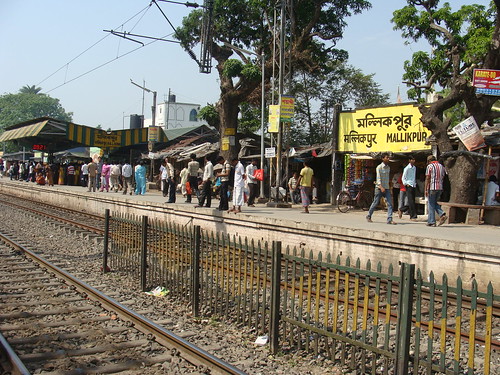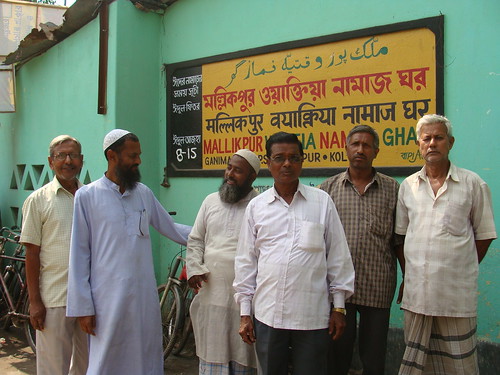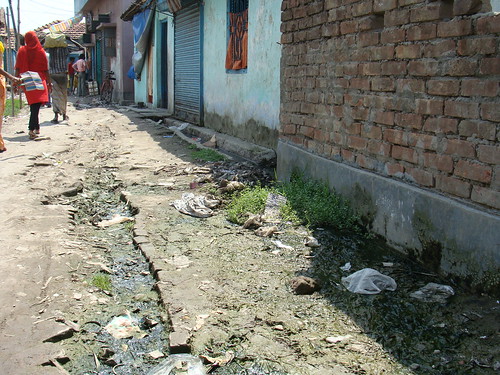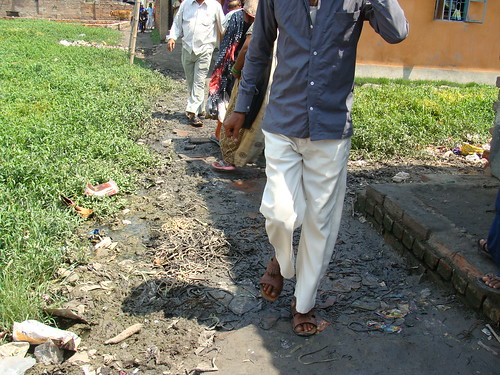By Mumtaz Alam Falahi, TwoCircles.net,
Ganima village, South 24-Parganas: Uncommon, but it’s true. A railway track has divided an area into two parts and given different status to each. The Ganima village runs along the track and is the gateway to the heavily Muslim-dominated panchayat of Mallikpur in this minority concentrated South 24-Parganas district in West Bengal.

Mallikpur railway station
The area on left side of the railway line is dominated by Hindus and comes under municipality while the Muslim dominated area on the other side comes under panchayat system. Difference is visible: the municipal area has minimum basic facilities – road, water, electricity and garbage collection and drainage cleaning by the municipality.
Generally it will be foolish to expect such things in a panchayat area. The case is almost same with Mallikpur panchayat.

Muslims in Mallikpur panchayat, South 24-Parganas
“We do not have drinking water, electricity and road. We also need drainage system and sanitation,” says Maulana Ansar of Ganima village.
“Lack of facilities here is due to our area being under panchayat,” adds the maulana.
Not only this, the panchayat having 20 villages of 1.5 lakh population together has also not sufficient facilities for education and communication. “The main problem is the lack of educational and communication facilities here,” says Amjad Hussain, former deputy head of the panchayat.
As means of communication, there are thelas which people use to reach their village from Mallikpur railway station – the station connects the area to Kolkata as there are some local trains which run on the route.

No drainage system
Qamrunnisa, homemaker at Habib Chowk area in Mallikpur panchayat, narrates the problems she and co-villagers have to face in rainy season as there is no pucca road. “We have been requesting the local authorities for giving us a proper road. But they turned deaf ear to our demand. We are just tired,” says Qamrunnisa.
Sheikh Shah Jahan, a school teacher who lives in Panchghara village in the same panchayat, says: “In my village there are 2000 homes, Mostly Muslims. There is just one primary school. For high school children have to walk three kilometers. We do not have sufficient number of schools in the panchayat.” Roughly there are about 50000 Urdu speaking people but there is just one Urdu primary school.
Stats
Mallikpur Panchayat has 20 villages comprising about 1.5 lakh population mostly Muslims. The panchayat comes under Baruipur block which is an identified minority concentration block. South 24-Parganas, which has 22 such minority concentration blocks, is among 12 Minority Concentration Districts in West Bengal. The minority population in South 24-Parganas is 34.06%. South 24-Parganas is in Category A of Minority concentration districts. Under this category are districts which have both socio-economic and basic amenities indicators below national average.
The panchayat comes under Baruipur West assembly seat which is held by Rahul Ghose of CPM.

Residents negotiating with the filthy path
Why have the Muslim dominated areas been forced to live in
backwardness in last 33 years of Left rule? Dr Sheikh Abdus Salam, former block samiti member in Mallikpur Panchayat, admits: “No government cares about Muslim areas. No party is good for Muslims – neither CPM, nor Trinamool, nor BJP.” Salam is member of CPI-M.
Vox Populi
People say they want change. After narrating their woes they say they want to change the government. Amjad Hussain says: “Yes, we want change.” “Change may occur,” says Mohd Saifuddin. Mohd Meraj, a youth from the area says: “Change may bring good. We hope change may bring development to the area.”

